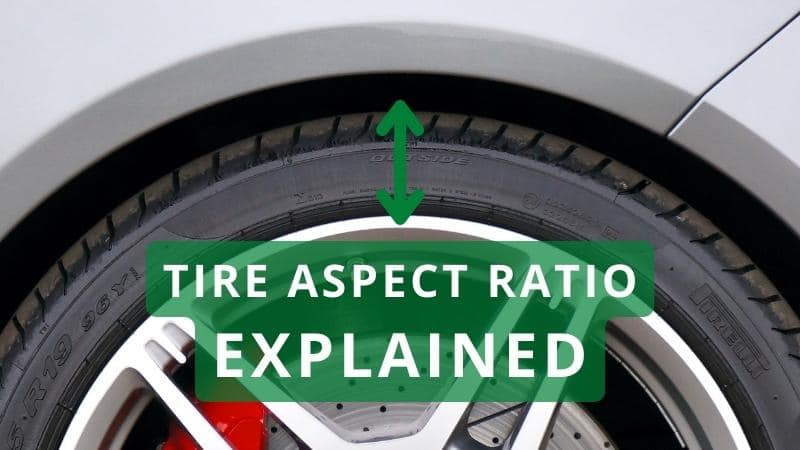Car tires do an excellent job of keeping a vehicle on the road in different conditions. For your tires to perform the best, you need to ensure that they are the correct size for your vehicle.
There are various components that determine tire sizes, and if you pay attention to them, you will pick something that works for your car.
Speaking of tire sizes, the numbers on the sidewalls can be very confusing because some are written in inches and others in millimeters. Luckily, the owner’s manual has the size recommendations for the tires you should use on your car.
If you want to change your tires for a sporty look or performance, start by checking the aspect ratio and diameter with the help of a professional.
These numbers are precisely calculated to point out the tire size and how it will fit your car. Below is a complete guide to tire aspect ratios with more details to help you understand how your tires work.
Keep reading to find out how to read your tire profile and adjust when necessary.
What is Tire Aspect Ratio?
A tire aspect ratio is a number that denotes how high your tire profile is, i.e. sidewall height. It can be seen on the tire’s sidewall after the slash mark on the number. For example, P225/50R17, where 50 is the aspect ratio given in percentages, and it is calculated by dividing the sidewall height by the tire width.
A tire with a 50 aspect ratio means that the tires profile is 50% the size of the tires width. The aspect ratio is calculated when the tire is filled with the appropriate air pressure, mounted on the required measuring rim, and has no load.
Calculating aspect ratio: Height of the tire (H) / Width of the tire (W) X 100 = Aspect Ratio (%)
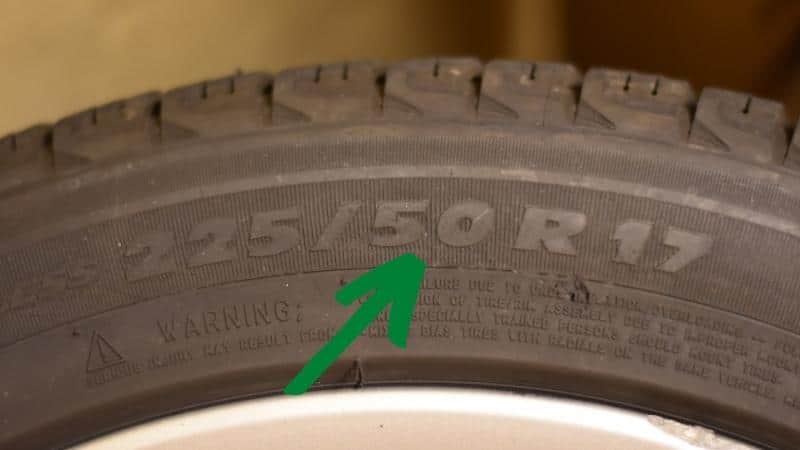
In the past, tire manufacturers produced 100 types of tires with the same height and width. Current market standards have wider tires with aspect ratios of 60, 70, or 80, which are very common. The series determine the tire width ratio, so a ratio of 70 will be identified as 70 series.
Aspect ratios are either square or round and impact surface area on an object. A tire’s aspect ratio is crucial because different vehicles have specific aspect ratio requirements that will make the tire fit. Therefore, you must know the type of vehicle you are driving and measure the wheelbase and track to determine the appropriate variety of tires you should be riding.
What is Tire Width?
The width of a tire is usually recorded in inches, and you can get this information on the tire’s sidewall. The typical size is recorded in millimeters, and it is written on the sidewall. To calculate the width of a tire, you have to measure the distance from one side of the outer edge to the other.
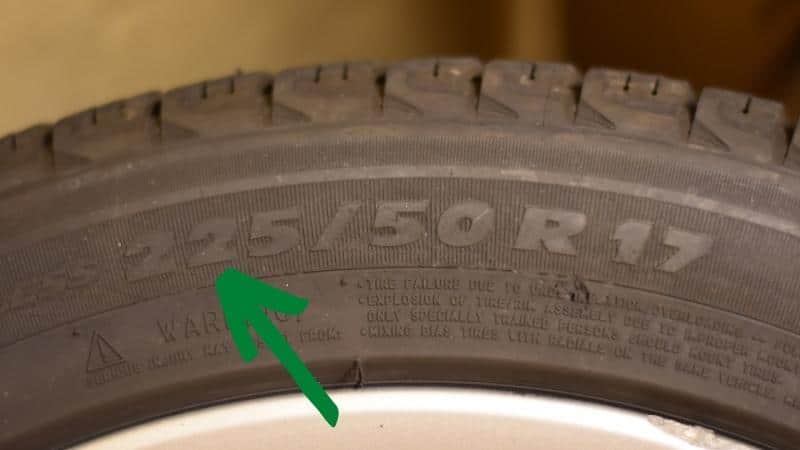
The width depends on whether the tire is for a car, SUV, or truck and its size. The widths vary from 8-22 inches, depending on the vehicle you want to install them on. Heavy-duty tires are typically larger than passenger car tires.
What is Tire Diameter?
The diameter of a tire is the distance from one end to the other, and it is recorded in inches. Wheel diameter significantly affects handling and performance on the road. The diameter is also crucial because it impacts the vehicle’s ground clearance and center of gravity.
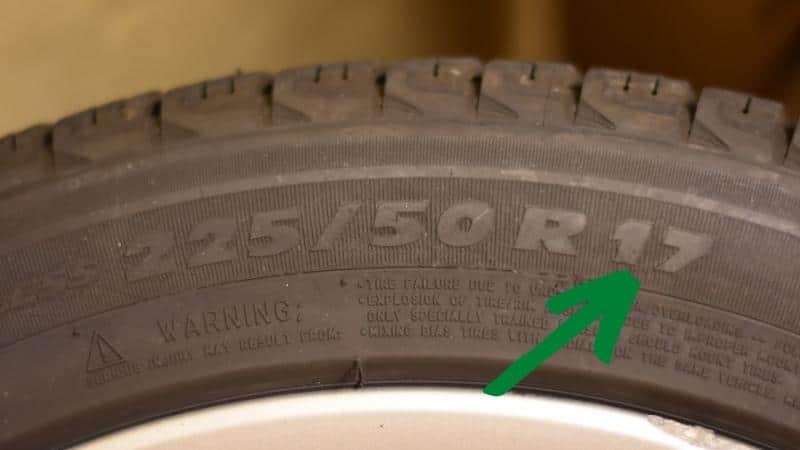
On the sidewall, there are digits that indicate how large the wheel is and its carrying capacity. It can guide a driver to determine the type of tire they need to fit on their car. The diameter must also match the width, or they will not work.
You can change all other aspects of the tire, but the diameter is one area you should not interfere with. Even though it is possible to ride varying tire sizes, the rim diameter must be consistent.
How Does The Tire Aspect Ratio Affect Driving Performance and Handling?
The aspect ratio of a tire determines its width in relation to the height and requires that every driver must understand the relationship between speed and tire size.
A larger tire with a higher aspect ratio has increased resistance to rolling, meaning that it requires extra force to propel the car forward. When more force is used to push the car forward, acceleration is reduced, meaning that when you stop the tires from rolling, you will not have enough force to get them moving as quickly as you would with smaller tires and a lower aspect ratio.
Smaller tires have lower rolling resistance meaning they can accelerate faster on any road regardless of the speed. Once a smaller tire is stopped, it requires less force to push it forward because of reduced inertia.
Considering that a tire’s width is relative to the height, the slower it takes to accelerate and decelerate. On the brighter side, these characteristics signify improved traction when driving on wet surfaces or unpaved roads.
Racing wheels usually have narrow wheels to enhance performance. The tire aspect ratio also determines the air pressure in the wheels. This can vary from vehicle to vehicle depending on the weight, tire size, and whether it is a two-wheel drive or four-wheel drive.
Vehicles riding on bigger wheels have reduced pressures because they are bulky and require more support. Smaller tires on cars need high pressure, which improves agility.
How Does Tire Aspect Ratio Affect Driving Speed?
Tires’ sizes are determined by their widths and diameters. This means that you can find the exact size of car tires with different aspect ratios. The aspect ratio can interfere with the vehicle’s speed because it mainly depends on the car’s weight spread over the contact surface with the road.
An increased contact patch improves grip on dry roads, meaning you can handle your vehicle correctly and stay in control. A smaller aspect ratio means that you will have less contact area, which affects handling even at lower speeds.
When you understand the tire’s aspect ratio, you will learn how to set up your car for the various road conditions you drive on. Tires with a low aspect ratio have better handling on straight roads or highways because they are more stable and lower the chance of emergency cornering, braking, and corrections.
Higher or Lower Tire Aspect Ratio: Which is Better?
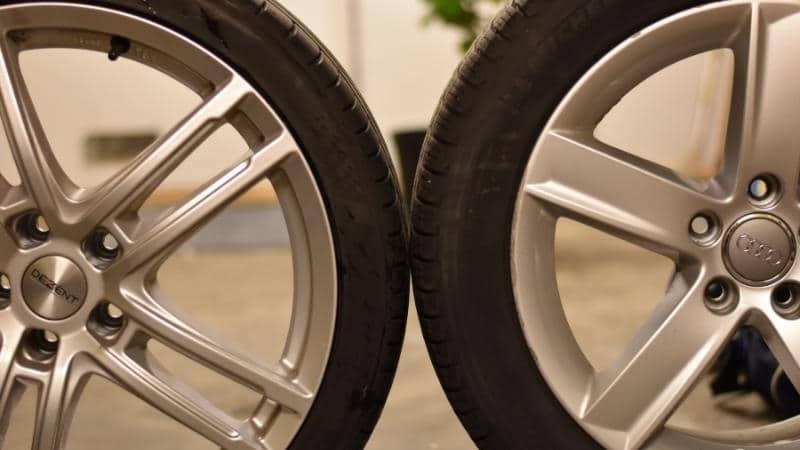
Whether a higher or lower tire aspect ratio is better for you depends on your vehicle type and driving style.
A higher aspect ratio is considered better than a low aspect ratio because the wheels have extra rubber to absorb shock against bumps, road irregularities, and impacts. Heavy vehicles like buses, trucks, and SUVs can have higher aspect ratios up to 95. Even though this may not be good for vehicle handling, it results in a comfortable ride.
Low-profile tires have a reduced sidewall compared to high-profile tires hence a bigger wheel diameter. A lower aspect ratio, i.e. low-profile, implies that the tire has a wider contact area which improves performance. The increased contact surface with the road is crucial for handling, cornering, and braking.
A lower tire aspect is stiff and less affected by deformation and damage when subjected to lateral G-forces when cornering, suitable for steering response. Low-profile tires are also appreciated for having a sporty and prestigious look.
Tires with a lower aspect ratio can compromise the comfort of a vehicle because more vibrations are transferred from the tire directly to the suspension. This happens when the tire has less air to absorb impact and vibrations.
Is it OK to Change The Tires Aspect Ratio?
If you consider your tire’s aspect ratio, you must first consider whether you want comfort or performance. You must stick to the manufacturer’s recommendations for optimal tire performance.
Changing to a higher aspect ratio will increase the ground clearance on your car, which results in poor handling, fuel economy, and drivetrain performance. The vehicle will respond differently on the road and impact the power needed for turning. The car will be less efficient with poor handling and safety.
A smaller aspect ratio will make the ride bumpier and stiffer. The vehicle’s dimensions will also change, including the height and width. These are factors you should consider when looking for an attire change.
Which Tire Aspect Ratio Should You Choose?
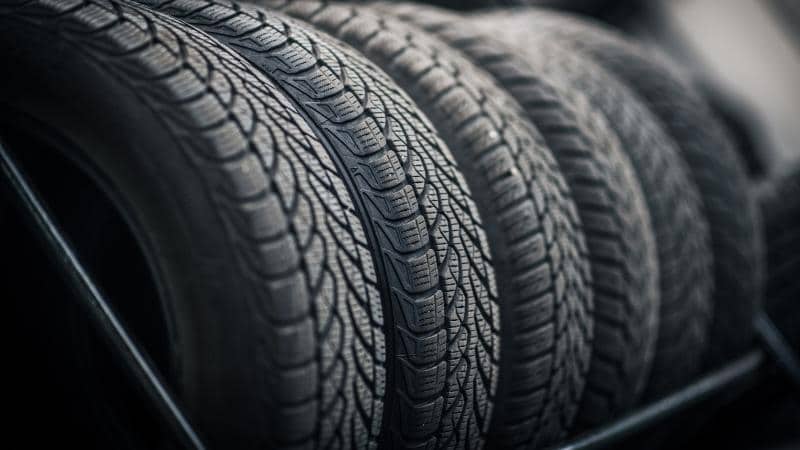
The aspect ratio is given as a percentage to enable drivers to establish the tire’s shape and the relation between the width and height. Profiles have changed over time to improve handling on roads. A small change in the tire profile could describe different tire types, which categorizes the tire range in multiple size groups conveniently.
Therefore, if you want a raised vehicle with more ground clearance, you need a tire with a taller sidewall. Large and heavy vehicles like trucks and buses have higher aspects ratios to absorb impact and make the ride comfortable. However, these tires could be slower because of more air pressure.
If you need a faster car, consider tires with a low aspect ratio and more contact patch with the ground. These tires are known to have better handling with less rolling on the corners. A low-profile tire also has increased g-force resistance when cornering.
How do You Find The Correct Tire Aspect Ratio?
First, you must research the tires you have on your vehicle to confirm the specifications. This ensures that you get the appropriate aspect ratio to give you a better driving experience.
Passenger cars usually have a tire aspect ratio of between 45 and 65, but this can change depending on the rim diameter. These can range anywhere between 16 to 20 inches. If you consider wider tires, go with the lower aspect ratio within the same wheel diameter as specified by the manufacturer.
Sports cars generally have tires with a lower aspect ratio to reduce ground clearance, increase ground contact and to also provide more sturdy tires. The aspect ratio for high-performance vehicles should be around 30 to 35 percent. These improve speeds and handling.
If you are to put these wheels on a passenger car, they will affect the acceleration, and they will be subject to damage due to increased pressure on the sidewalls.
Does Tire Aspect Ratio Have to Match on All Your Wheels?
Considering the vehicle dynamics and driving experience, you must have the same tire aspect ratio for all your wheels. Different tire profiles for either axle will make the car imbalanced and respond negatively on the road. Your vehicle will therefore be less efficient with poor handling and driving safety.
How do You Plus Size Your Tires?

If you want to change your tires’ aspect ratio and width, there is a plus sizing formula you need to follow. Every increment in width on the tire reflects one decrement in the aspect ratio. For example, if your tires are 205/60 R15 and you want wider wheels, go for 215/55 R15.
Changing the rim height also means that you will change the aspect ratio. You can go for a 215/50 R16 or double size of 235/40 R17. Plus-sizing can improve traction and braking due to increased contact patch.
The taller wheel will roll slower to cover the same distance as the original wheels. Your speedometer will respond by giving wrong readings.
If you are not sure about the proper aspect ratio for new tires, tire size calculators can help you adjust accordingly. Whether you are driving a passenger car, crossover, SUV, sports car, or light truck, any slight change in the diameter, width, or aspect ratio will impact your performance.
A higher sidewall makes the ride smoother because the tire can roll over bumps, debris, and twigs without putting excess pressure on the suspensions.
Changing the aspect ratio also means that you will have to adjust your brakes to accommodate the larger wheels. It is advisable that you do this with the help of an expert.
Hi, my name is Niklas, the head content creator & CEO of Whirling Wheelz. I am very interested in vehicles of all kinds, mainly cars. I have a car mechanics degree from high school and a big hobby of mine is to follow the WRC (World Rally Championship) both online and through travel.

